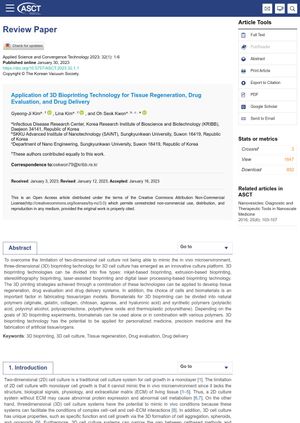Application of 3D Bioprinting Technology for Tissue Regeneration, Drug Evaluation, and Drug Delivery
January 2023
in “
Applied Science and Convergence Technology
”

TLDR 3D bioprinting is useful for making tissues, testing drugs, and delivering drugs, but needs better materials, resolution, and scalability.
The document discusses the use of 3D bioprinting technology in tissue regeneration, drug evaluation, and drug delivery. Five types of 3D bioprinting technologies are explored, with the choice of cells and biomaterials being crucial in fabricating tissue/organ models. The technology has been used in tissue regeneration to create structures like hair follicles, skin implants, and blood vessels. For drug evaluation, it has been used to develop in vitro tissue/organ models for drug screening. In drug delivery, it has been used to design customized drug products. However, there are challenges in replicating in vivo structural complexity and cellular organization, with issues in biomaterial selection, cell deposition, and vascular network refinement. Improvements in printing resolution, speed, biocompatibility, development of novel biomaterials, in situ bioprinting, construction of functional structures, and scalability are needed.




